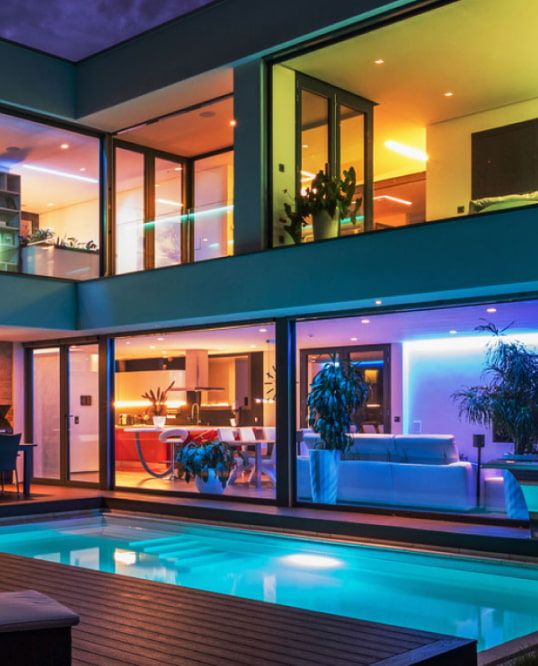In the realm of home automation, lighting plays a pivotal role. The ability to effortlessly control the illumination levels, color temperature, and even ambience of a room can dramatically enhance comfort, convenience, and energy efficiency. Wireless lighting systems, in particular, have emerged as the preferred choice for modern homes, offering unparalleled flexibility, ease of installation, and a myriad of advanced features.
Smart Lighting Systems for the Modern Home

Lighting is an integral part of creating the perfect ambiance in our living spaces. It can transform the mood, enhance productivity, and even contribute to our well-being. Traditional lighting systems, however, are often limited in their functionality, requiring manual adjustments or complex wiring configurations. Smart lighting systems, on the other hand, leverage advanced technology to provide unparalleled control over lighting. They employ wireless communication protocols, such as Bluetooth, Zigbee, or Wi-Fi, to connect lighting fixtures to a central hub or smartphone app. This allows users to remotely control lights from anywhere, adjust brightness levels, and even create automated schedules and scenes.
The Rise of Connected Lighting
The emergence of the Internet of Things (IoT) has paved the way for the development of smart lighting systems. These systems integrate seamlessly with other smart home devices, creating a cohesive and interconnected ecosystem. By connecting lighting fixtures to a central control system, users can enjoy a range of advanced features, such as voice control, integration with home assistants, and automated energy-saving settings.
Personalized Lighting Experiences
One of the key benefits of smart lighting systems is their ability to provide personalized lighting experiences. Users can customize the color temperature, brightness, and even the color of the light to suit their preferences and activities. This level of personalization can enhance the ambiance of a room, creating the perfect atmosphere for relaxation, entertainment, or productivity.
Automated Lighting Schedules
Smart lighting systems also offer the convenience of automated lighting schedules. Users can set up routines and schedules that automatically adjust the lighting based on the time of day, occupancy, or even external factors like sunrise and sunset. This not only ensures that the lighting is tailored to the household’s needs but also contributes to energy savings by reducing unnecessary lighting usage.
Integrating with Smart Home Devices
The true power of smart lighting systems lies in their integration with other smart home devices. By connecting to a central hub or platform, users can seamlessly control lighting alongside other smart home features, such as security systems, thermostats, and appliances. This level of integration allows for a truly cohesive and optimized smart home experience.
Enhancing Accessibility and Inclusivity
Wireless lighting systems can also play a crucial role in enhancing accessibility and inclusivity within the home. For individuals with physical or cognitive disabilities, the ability to control lighting with voice commands, touchscreen interfaces, or even gestures can greatly improve their independence and quality of life. Additionally, smart lighting can be programmed to provide visual cues or alerts, assisting those with hearing or visual impairments.
Expanding with Modular Design
Many modern wireless lighting systems feature a modular design, allowing homeowners to easily expand their setup as their needs evolve. This flexibility enables users to start with a basic configuration and gradually add more lighting fixtures, sensors, and control points as their smart home ecosystem grows. The modular approach ensures that the lighting system can adapt to the changing requirements of the household.
Seamless Integration with Home Automation Platforms
Wireless lighting systems are designed to integrate seamlessly with leading home automation platforms, such as Amazon Alexa, Google Home, Apple HomeKit, and Samsung SmartThings. This integration allows users to control their lighting through voice commands, mobile apps, or centralized smart home hubs, creating a cohesive and user-friendly experience.
Enhancing Efficiency with Wireless Lighting Systems

One of the primary benefits of wireless lighting systems lies in their ability to enhance energy efficiency. By leveraging advanced technology and smart features, these systems can contribute to significant energy savings and reduced environmental impact.
Intelligent Lighting Schedules
Wireless lighting systems can be programmed to automatically adjust lighting based on factors such as time of day, occupancy, and user preferences. This intelligent scheduling ensures that lights are turned on only when necessary, reducing energy consumption and minimizing wasteful lighting usage.
Occupancy-Based Lighting Control
Many wireless lighting systems incorporate occupancy sensors that can detect the presence of people in a room. When a room is unoccupied, the lighting can be automatically dimmed or turned off, further contributing to energy savings.
| Feature | Description |
|---|---|
| Intelligent Scheduling | Automated lighting adjustments based on time of day, occupancy, and user preferences |
| Occupancy-Based Control | Lighting adjustments in response to the presence or absence of occupants |
| Daylight Harvesting | Automatic lighting adjustments based on the available natural light in a room |
| Energy Monitoring | Tracking and reporting of energy consumption for individual lighting fixtures or the entire system |
Daylight Harvesting
Wireless lighting systems can also integrate with daylight sensors to enable daylight harvesting. This feature automatically adjusts the indoor lighting levels based on the available natural light, ensuring that artificial lighting is only used when necessary. By leveraging natural light, these systems can significantly reduce energy consumption and lower utility bills.
Energy Monitoring and Reporting
Advanced wireless lighting systems often include energy monitoring capabilities, allowing users to track and analyze the energy consumption of individual lighting fixtures or the entire system. This data can be used to identify areas of high energy usage, enabling homeowners to make informed decisions about their lighting usage and implement more energy-efficient strategies.
Reduced Maintenance and Operational Costs
Wireless lighting systems can also contribute to long-term cost savings by reducing maintenance and operational expenses. The elimination of complex wiring and the ability to remotely control and monitor the lighting system can significantly decrease the need for in-person maintenance and troubleshooting.
Integration with Renewable Energy Sources
Wireless lighting systems can be seamlessly integrated with renewable energy sources, such as solar panels or wind turbines, further enhancing their energy efficiency and sustainability. By leveraging renewable energy to power the lighting system, homeowners can reduce their reliance on the traditional grid and minimize their carbon footprint.
Adaptive Dimming and Color Temperature Adjustment
Many wireless lighting systems offer adaptive dimming and color temperature adjustment features. These capabilities allow users to fine-tune the lighting levels and color temperature to suit their preferences and activities, creating the perfect ambiance while optimizing energy usage.
- Adaptive Dimming: Adjusting the brightness of the lighting based on user preferences or environmental factors
- Color Temperature Adjustment: Changing the color temperature of the light to create different moods and environments
Increased Lifespan of Lighting Fixtures
The integration of advanced technology in wireless lighting systems can also contribute to the increased lifespan of lighting fixtures. By incorporating features like intelligent power management and thermal regulation, these systems can extend the useful life of the LED bulbs and other lighting components, reducing the frequency of replacements and further enhancing the overall cost-effectiveness of the system.
Wireless lighting systems have revolutionized the way we approach lighting in our homes. By offering seamless control, enhanced flexibility, and a host of energy-saving features, these systems have become the preferred choice for modern homeowners seeking to create personalized, efficient, and technologically-advanced living spaces.
The integration of smart home technologies, personalized lighting experiences, and energy-efficient capabilities have made wireless lighting systems a game-changer in the home automation industry. As technology continues to evolve, we can expect to see even more advanced features and capabilities being introduced, further enhancing the user experience and contributing to a more sustainable and energy-conscious future.
In conclusion, the adoption of wireless lighting systems has ushered in a new era of lighting control and flexibility, empowering homeowners to transform their living spaces into truly smart, efficient, and personalized environments. As the demand for intelligent and eco-friendly home solutions continues to grow, the importance of wireless lighting systems will only become more pronounced, solidifying their position as an essential component of the modern smart home.


